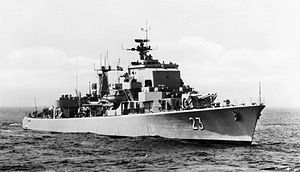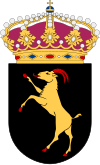HSwMS Hälsingland (J23)
 HSwMS Hälsingland
| |
| History | |
|---|---|
| Name | Hälsingland |
| Namesake | Hälsingland |
| Ordered | March 1953 |
| Builder | Götaverken |
| Launched | 14 January 1957 |
| Commissioned | 17 June 1959 |
| Decommissioned | 1 July 1982 |
| Identification | Pennant number: J23 |
| Fate | Scrapped |
| Badge |  |
| General characteristics [1][2] | |
| Class and type | Östergötland-class destroyer |
| Displacement |
|
| Length | 112 m (367 ft 5 in) |
| Beam | 11.2 m (36 ft 9 in) |
| Draft | 3.7 m (12 ft 2 in) |
| Propulsion | 2 shaft geared turbines, 2 boilers, 47,000 hp (35,000 kW) |
| Speed | 35 kn (65 km/h) |
| Range | 3,000 nmi (6,000 km) at 20 knots (37 km/h) |
| Armament |
|
HSwMS Hälsingland (J23) was the fourth ship of the Östergötland-class destroyer.[3]
Design[edit]
Due to time and cost, HSwMS Östergötland, like the other ships in the class, was built largely according to the drawings of the Öland-class destroyer. The length of the ship was 111.8 meters and the beam was 11.2 meters. Due to different equipment, however, the new vessels became about 200 tons heavier, which gave a draft of 3.7 meters, against the Öland-class of 3.4 meters. The machinery consisted of two oil-fired steam boilers of the Babcock & Wilcox brand, which supplied steam with a pressure of 32 bars to two steam turbines of the DeLaval brand, which in turn each operated a propeller. The machinery gave the effect 47,000 horsepower on the axles, which gave a top speed of 35 knots.
The main guns consisted of four 120 mm (4.7 in) guns m/44 placed in two double towers, one on the foredeck and one on the aft deck. From the beginning, the air defense consisted of seven 40 mm automatic cannons w / 48 E. These were placed two for the superstructure, one on each side amidships, and three on the aft bridge. Around 1965, the middle cannon on the aft bridge was replaced by the anti-aircraft missile Robot 07,[4] and to increase the stability of the ship, the two cannons were removed at the same time amidships.[5] For the same reason, all six torpedo tubes were also placed in a tube rack, having previously stood in two racks. There were also two submarine bombers and 58 mines on board.
History[edit]
Hälsingland was built at Götaverken in Gothenburg and was launched on 14 January 1957 and commissioned on 17 June 1959.
Gästrikland was decommissioned on 1 July 1982, after which her superstructure has been dismantled and transferred to Upper Norrland's military area, where they were intended to be used for invasion defense. However, she were never used but were later scrapped. The hull was used by disposal of FOA for explosive tests, before it was sold for scrap in Karlskrona.
References[edit]
Notes[edit]
- ^ Conway's All the World's Fighting Ships 1947-1995
- ^ "Jagaren Småland" [Destroyer Småland]. Maritiman. Archived from the original on 10 February 2017. Retrieved 20 July 2015.
- ^ encyclopedia, david bocquelet-Naval. "The Swedish Navy in the Cold War (Svenska Marinen )". www.naval-encyclopedia.com. Retrieved 2021-08-07.
- ^ Borgenstam, Curt (1989). Jagare : med svenska flottans jagare under 80 år (2:a). Karlskrona: Västra Frölunda CB Marinlitteratur. ISBN 91-970700-41.
- ^ von Hofsten, Gustav (January 2003). Örlogsfartyg: Svenska maskindrivna fartyg under tretungad flagg. Karlskrona: Svenskt Militärhistoriskt Bibliotek. ISBN 91-974015-4-4.
Print[edit]
- Borgenstam, Curt; Insulander, Per; Kaudern, Gösta (1989). Jagare: med Svenska flottans jagare under 80 år (in Swedish). Västra Frölunda: Marinlitteratur. ISBN 91-970700-4-1. SELIBR 7792227.
- Gardiner, Robert; Chumbley, Stephen (1995). Conway's All The World's Fighting Ships 1947–1995. Annapolis, Maryland, USA: Naval Institute Press. ISBN 1-55750-132-7.
- Hofsten, Gustaf von; Waernberg, Jan; Ohlsson, Curt S. (2003). Örlogsfartyg: svenska maskindrivna fartyg under tretungad flagg. [Forum navales skriftserie, 1650-1837 ; 6] (in Swedish). Stockholm: Svenskt militärhistoriskt bibl. i samarbete med Marinlitteratur. ISBN 91-974384-3-X. SELIBR 8873330.
External links[edit]
